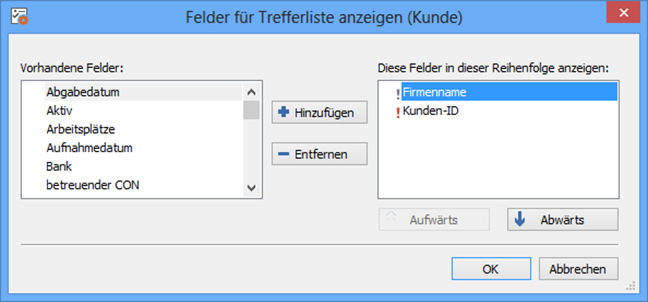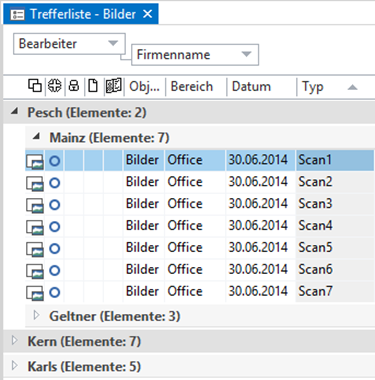The hit list will be displayed as a table. Folders, registers, and documents will be listed line by line.
Hit lists consist of static columns that provide information about object data, and columns, which contain the index data of the found objects. Hit lists from full-text searches also display a column with a text passage and the search term found within it. These hits are sorted in the hit list according to their quality.
Static Columns
Static columns contain the name of the object type, as well as icons showing the archiving status, the access status, the presence of notes, and so forth. Which of these columns are shown depends on your settings in the enaio® client settings (see 'Fields' area ).
Static columns are also displayed context-specific. This means that a "Signatures" column is not displayed in a hit list of folders or registers, for example, because folders or registers cannot be signed.

Type icon/icon catalog | File format | Links | Text notes | Preview annotations | Favorites | Object | Index data

Type icon/icon catalog | File format | Archiving status | Access status | Links | Signature status | Text notes | Preview annotations | Favorites | Object | Index data
| Icon | Name | Comment |
|---|---|---|
|
|
Type icon/icon catalog |
Displays the type icon, a standard icon for the module, or a type-specific icon. If the object contains an icon catalog under the index data fields, then the corresponding icon is shown here. |
|
|
File format |
Displays the file format as an icon and detailed as a tooltip. Example: Word/docx The file format is not displayed for cross-type link documents. |
|
|
Archiving status |
Shows whether a document is approved for archiving or has already been archived. |
|
|
Access status |
Shows whether the document can be edited and whether variants exist. |
|
|
Links |
Indicates whether a folder, register, or document is linked to others or if a folder or register has been shared using enaio® coLab. |
|
|
Signature status |
Indicates if the document is signed. |
|
|
Text notes |
Indicates whether a folder, register, or document has notes. |
|
|
Preview annotations |
Shows whether the document contains preview annotations. |
|
|
Favorites |
Indicates whether a folder, register, or document is tagged as a favorite. |
|
|
Object |
Shows the object type name. |
Customization Options for Hit Lists
Other columns display the index data. In the default settings, you can individually configure the index data fields to be displayed as hit list columns for each object type (see Default settings for the hit list). You can also select the fields for the hit list using the Show hit list fields dialog in the object search. This dialog can be opened via the context menu of a selected object in the object search (see Document Type Options).
For documents, you can select fields from the basic parameters and from the folder index data as list columns; for folders and registers, you can select fields from the basic parameters.
Index data from table fields and multi-fields cannot be shown in a hit list.
The following customization options are available for hit lists:
The number of hits in a hit list can be limited by the administrator. If the hit list does not show all hits, you will be shown a message in the status bar of the hit list.
All users can individually specify the number of hits in the settings (see 'Query behavior' area ); however, the maximum number is always the number of hits specified by the administrator.
For a clearer overview of results, you can also set alternating background colors for the rows in the hit list.
You can specify which columns are shown in a hit list. To select which columns to display, choose Fields for hit list from the context menu of a hit list column header.
The configuration of the hit list column display will apply to the object type that you have selected in the hit list. The title bar of the Show hit list fields configuration dialog indicates (in brackets) the object type that is currently being configured. For mixed hit lists, you may need to configure multiple object types to get the desired hit list format. The Show hit list fields configuration dialog can alternatively be opened via the settings menu (see 'Fields' area ) or via the context menu of an object type in the object search. Since the hit list column display is configured for one object type, the settings apply to all hit lists as well as portfolios, folder windows, etc.
You can also configure the text alignment of the columns in a hit list. To do so, right-click the column header, select Alignment, and choose the desired text alignment (left-aligned, centered, or right-aligned) from the context menu.
You can use the mouse to change the column widths.
Click a list column to highlight it in color and sort the list alphabetically in ascending or descending order according to the entries in this column. Click again on the same list column to reverse the order in which the entries are sorted.
You can select other columns to sort by pressing Ctrl+Shift+Left mouse button. The columns are flagged.
If you do not define how the hit list objects are sorted, this will be done in the following order: folders, registers, and documents. Folders and registers are listed alphabetically. If the hit list contains multiple folders or registers with identical names, they will be sorted by folder or register ID in ascending order. Documents are sorted by the modules with which they were created in the following order:
-
Grayscale images
-
Black-and-white images
-
Color images
-
Windows documents
-
Video documents
-
E-mail documents
-
XML documents
-
Container documents
If several documents in the hit list were created using the same module, they are sorted by object type, and if multiple documents of the same object type exist, they are sorted by document ID in ascending order.
You can select other columns to sort by pressing Ctrl+Shift+Left mouse button.
You can cancel sorting for hit lists by opening the context menu in the hit list header and clicking Sort > Remove all.
Via the context menu of a column title, you can pin the columns on the left to the active index data column. When scrolling left to right or right to left, only the columns on the right are scrolled. Pinned columns are saved with the column configuration.
Use Ctrl+Scroll wheel to increase or decrease the font size in hit lists. Alternatively, you can also change the font size by selecting the matching entry in the context menu in the column header of a hit list. The font size setting is user-specific and is saved to ensure it is still available after enaio® client is restarted.
If you select Save column configuration from the context menu of the table header line, the grouping settings and font size will also be saved.
Grouping Hit Lists
You can show the hits in the hit list more clearly by grouping the hit list.
Right-click the column header of the column whose content you want to use to group the hits and select Group from the context menu. The hits are sorted into groups according to the entries in this column.
You can group hit lists multiple times in the same way.
You can show the grouping area via the context menu of the column header above the hit list. The grouping area displays the column grouping in a hierarchical view. You can drag columns for grouping into the grouping area. In the grouping area, you can modify the grouping sequence by dragging the column headers to a new position.
The header row of each grouped section contains the number of elements of this group (either the number of objects or the number of groups) if you have set several groupings. Size ranges are shown for groupings for file size.
You can expand or collapse the groupings using the ![]() Arrow icons in the headers or with the +/- buttons on the numeric pad of your keyboard. For a clearer overview, you can also set alternating background colors for the rows in the hit list.
Arrow icons in the headers or with the +/- buttons on the numeric pad of your keyboard. For a clearer overview, you can also set alternating background colors for the rows in the hit list.
You can disable groupings for single or multiple column headers in the context menu.
If you use the Save column width feature to save the hit list settings, the grouping settings will be saved as well.
Configurations for Portfolios and Queries
You can assign your own column configurations to typed portfolios and saved searches, independently of the hit list adjustments (see Customizing Column Configurations for Portfolios and Customizing the Column Configuration for Saved Searches).
Report View and Quicklook View
Instead of being displayed as a table in the report view, the document hit list can be displayed in the quicklook view. Quicklooks are small previews (thumbnails) of the first page of a document. They are only available for image documents and documents created using Microsoft Office applications. While setting up document types, the administrator can decide whether quicklooks are created or not.
Click the matching button on the status bar to switch between the report and quicklook views.
Searching in Hit Lists
Use the keyboard shortcut Ctrl+F to search in hit lists. If you use the shortcut, you can enter the search term in the Filter list field at the bottom of a hit list. The hit list is restricted. The search term or cells containing the term you are searching for are highlighted in color.




 areas. Use the toolbar to show all hidden areas at once:
areas. Use the toolbar to show all hidden areas at once:
